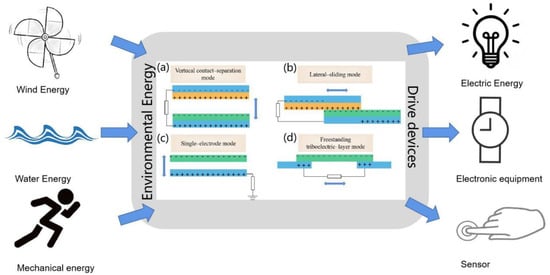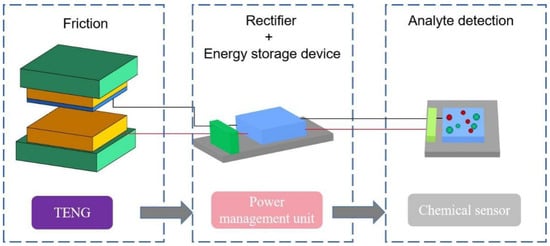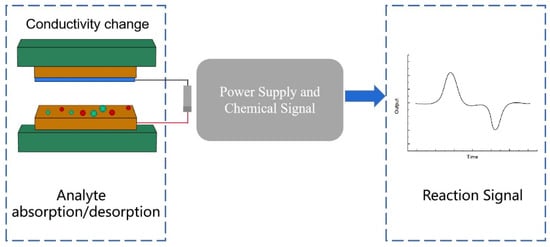The rapid development of sensing technology has created an urgent need for chemical sensor systems that can be rationally integrated into efficient, sustainable, and wearable electronic systems. In this case, the triboelectric nanogenerator (TENG) is expected to be a major impetus to such innovation because it can not only power the sensor by scavenging mechanical energies and transforming them into electricity but also act as the chemical sensor itself due to its intrinsic sensitivity towards the chemical reaction that occurs at the triboelectric interface.
- triboelectric nanogenerator
- chemical sensor
- self-powered
1. Introduction
2. Basic Principle of TENGs
2.1. Working Mode of TENGs

2.2. Working Principle
3. Progress of TENG-Based Chemical Sensor Systems
3.1. Chemical Sensor Powered by TENG
3.1.1. Basic Principle

3.1.2. Design Criteria of TENG-Based Power Source
Power Management Approach
Performance Enhancement Strategy
Resistance to Harsh Conditions
3.1.3. TENG-Powered Chemical Sensors
Biosensors
Gas Sensors
Ion Sensors
3.2. TENG-Based Active Chemical Sensor
3.2.1. Basic Principle

3.2.2. Design Criteria of TENG-Based Active Sensors
Sensitivity Improvement
Integration Optimization
3.2.3. Applications of TENG-Based Active Chemical Sensors
TENG-Based Active Biosensors
Human body physiological signals are important physiological indicators for public healthcare and health monitoring [55]. Monitoring these small but complex physiological signals in real-time with simple, convenient, economical, and accurate methods remains a challenge for healthcare devices [56][57]. As a result, new methods for analyzing these biological analytes are required.
TENG-Based Active Gas Sensors
TENG-Based Active Ion Sensors
Other Active Sensors
4. Conclusions
TENG-based CSSs not only demonstrate the sensitive detection of physiological activity, gases, and ions but may also achieve independent, continuous, and reliable operation by scavenging mechanical energy from nature or biology. Although this TENG-based sensor system has achieved significant progress through the design strategy of TENG-based active sensors, it is still not systematic and comprehensive enough. The challenges that TENG-based power sources face are relatively simple; the enhancement of output performance is always the prime target, which can be effectively promoted by improved power management, material selection, and structure design. For TENG-based active sensors, the main starting point is the adsorption or chemical reaction of specific targets at the triboelectric interface, whose reliability is susceptible to environmental conditions and the TENG’s own signal interference. Nevertheless, in both cases, the coupling of different material properties can bring new insights into the design of TENG-based CSSs with higher performance, thus innovating their applications in a wide range of multidisciplinary areas, such as disease diagnosis, environmental monitoring, and the defense industry.
This entry is adapted from the peer-reviewed paper 10.3390/chemosensors10110484
References
- Yogeswaran, U.; Chen, S. A review on the electrochemical sensors and biosensors composed of nanowires as sensing material. Sensors 2008, 8, 290–313.
- Dong, X.; Yan, X.; Li, M.; Liu, H.; Li, J.; Wang, L.; Wang, K.; Lu, X.; Wang, S.; He, B. Ultrasensitive detection of chloramphenicol using electrochemical aptamer sensor: A mini review. Electrochem. Commun. 2020, 120, 106835.
- Gan, X.; Zhao, H. Understanding signal amplification strategies of nanostructured electrochemical sensors for environmental pollutants. Curr. Opin. Electrochem. 2019, 17, 56–64.
- Wijesinghe, M.S.; Batchelder, K.; Wickramasinghe, D.; Oh, J.; Chow, K. Battery-powered distance-based electrochemical sensor using a longitudinally-oriented silver band electrode. Sens. Actuators B Chem. 2020, 308, 127684.
- Brett, C.M.A.; Oliveira-Brett, A.M. Electrochemical sensing in solution—Origins, applications and future perspectives. J. Solid State Electrochem. 2011, 15, 1487–1494.
- Yan, L.; Mi, Y.; Lu, Y.; Qin, Q.; Wang, X.; Meng, J.; Liu, F.; Wang, N.; Cao, X. Weaved piezoresistive triboelectric nanogenerator for human motion monitoring and gesture recognition. Nano Energy 2022, 96, 107135.
- Downs, A.M.; Gerson, J.; Hossain, M.N.; Ploense, K.; Pham, M.; Kraatz, H.; Kippin, T.; Plaxco, K.W. Nanoporous gold for the miniaturization of in vivo electrochemical aptamer-based sensors. ACS Sens. 2021, 6, 2299–2306.
- Li, M.; Zhou, P.; Wang, X.; Wen, Y.; Xu, L.; Hu, J.; Huang, Z.; Li, M. Development of a simple disposable laser-induced porous graphene flexible electrode for portable wireless intelligent votammetric nanosensing of salicylic acid in agro-products. Comput. Electron. Agric. 2021, 191, 106502.
- Sánchez Del Río, J.; Yusuf, A.; Ao, X.; Olaizola, I.A.; López-Puertas, L.U.; Ballesteros, M.Y.; Giannetti, R.; Martínez, V.; Jiménez, J.L.; Monge, J.B.B.; et al. High-resolution tengs for earthquakes ground motion detection. Nano Energy 2022, 102, 107666.
- Zhang, C.; Bu, T.; Zhao, J.; Liu, G.; Yang, H.; Wang, Z.L. Tribotronics for active mechanosensation and self-powered microsystems. Adv. Funct. Mater. 2019, 29, 1808114.
- Nemčeková, K.; Labuda, J. Advanced materials-integrated electrochemical sensors as promising medical diagnostics tools: A review. Mater. Sci. Eng. C 2021, 120, 111751.
- Li, G.; Wen, D. Wearable biochemical sensors for human health monitoring: Sensing materials and manufacturing technologies. J. Mat. Chem. B 2020, 8, 3423–3436.
- Yu, Y.; Nyein, H.Y.Y.; Gao, W.; Javey, A. Flexible electrochemical bioelectronics: The rise of in situ bioanalysis. Adv. Mater. 2020, 32, 1902083.
- Jeerapan, I.; Poorahong, S. Review—Flexible and stretchable electrochemical sensing systems: Materials, energy sources, and integrations. J. Electrochem. Soc. 2020, 167, 37573.
- Dai, C.; Hu, L.; Jin, X.; Chen, H.; Zhang, X.; Zhang, S.; Song, L.; Ma, H.; Xu, M.; Zhao, Y.; et al. A cascade battery: Coupling two sequential electrochemical reactions in a single battery. Adv. Mater. 2021, 33, 2105480.
- Jiang, G.; Li, F.; Wang, H.; Wu, M.; Qi, S.; Liu, X.; Yang, S.; Ma, J. Perspective on high-concentration electrolytes for lithium metal batteries. Small Struct. 2021, 2, 2000122.
- Aller Pellitero, M.; Del Campo, F.J. Electrochromic sensors: Innovative devices enabled by spectroelectrochemical methods. Curr. Opin. Electrochem. 2019, 15, 66–72.
- Zhou, L.; Liu, D.; Liu, L.; He, L.; Cao, X.; Wang, J.; Wang, Z.L. Recent advances in self-powered electrochemical systems. Research 2021, 2021, 4673028.
- Liang, J.; Mondal, A.K.; Wang, D.; Iacopi, F. Graphene-based planar microsupercapacitors: Recent advances and future challenges. Adv. Mater. Technol. 2019, 4, 1800200.
- Parrilla, M.; De Wael, K. Wearable self-powered electrochemical devices for continuous health management. Adv. Funct. Mater. 2021, 31, 2107042.
- Kim, D.W.; Lee, J.H.; Kim, J.K.; Jeong, U. Material aspects of triboelectric energy generation and sensors. NPG Asia Mater. 2020, 12, 6.
- Wang, K.; Li, J. Electricity generation from the interaction of liquid–solid interface: A review. J. Mater. Chem. A 2021, 9, 8870–8895.
- Tan, G.; Ohta, M.; Kanatzidis, M.G. Thermoelectric power generation: From new materials to devices. Philos. Trans. R. Soc. A Math. Phys. Eng. Sci. 2019, 377, 20180450.
- Shafranjuk, S.E. Converting heat to electricity by a graphene stripe with heavy chiral fermions. Eur. Phys. J. B 2014, 87, 99.
- Zoui, M.A.; Bentouba, S.; Stocholm, J.G.; Bourouis, M. A review on thermoelectric generators: Progress and applications. Energies 2020, 13, 3606.
- Pilli, S.K.; Summers, K.; Chidambaram, D. Photoelectrochemical generation of hydrogen and electricity from hydrazine hydrate using bivo4 electrodes. Phys. Chem. Chem. Phys. 2015, 17, 13851–13859.
- Zhong, M.; Shi, J.; Xiong, F.; Zhang, W.; Li, C. Enhancement of photoelectrochemical activity of nanocrystalline cds photoanode by surface modification with tio2 for hydrogen production and electricity generation. Sol. Energy 2012, 86, 756–763.
- Ke, K.; Chung, C. High-performance al/pdms teng with novel complex morphology of two-height microneedles array for high-sensitivity force-sensor and self-powered application. Small 2020, 16, 2001209.
- Huang, C.; Chen, G.; Nashalian, A.; Chen, J. Advances in self-powered chemical sensing via a triboelectric nanogenerator. Nanoscale 2021, 13, 2065–2081.
- Chen, J.; Wang, Z.L. Reviving vibration energy harvesting and self-powered sensing by a triboelectric nanogenerator. Joule 2017, 1, 480–521.
- Fan, F.; Tian, Z.; Lin Wang, Z. Flexible triboelectric generator. Nano Energy 2012, 1, 328–334.
- Cao, X.; Jie, Y.; Wang, N.; Wang, Z.L. Triboelectric nanogenerators driven self-powered electrochemical processes for energy and environmental science. Adv. Energy Mater. 2016, 6, 1600665.
- Niu, S.; Wang, Z.L. Theoretical systems of triboelectric nanogenerators. Nano Energy 2015, 14, 161–192.
- Kim, W.; Kim, D.; Tcho, I.; Kim, J.; Kim, M.; Choi, Y. Triboelectric nanogenerator: Structure, mechanism, and applications. ACS Nano 2021, 15, 258–287.
- Yang, W.; Chen, J.; Zhu, G.; Yang, J.; Bai, P.; Su, Y.; Jing, Q.; Cao, X.; Wang, Z.L. Harvesting energy from the natural vibration of human walking. ACS Nano 2013, 7, 11317–11324.
- Wang, S.; Lin, L.; Xie, Y.; Jing, Q.; Niu, S.; Wang, Z.L. Sliding-triboelectric nanogenerators based on in-plane charge-separation mechanism. Nano Lett. 2013, 13, 2226–2233.
- Sun, H.; Zhao, Y.; Jiao, S.; Wang, C.; Jia, Y.; Dai, K.; Zheng, G.; Liu, C.; Wan, P.; Shen, C. Environment tolerant conductive nanocomposite organohydrogels as flexible strain sensors and power sources for sustainable electronics. Adv. Funct. Mater. 2021, 31, 2101696.
- Wang, S.; Xie, Y.; Niu, S.; Lin, L.; Wang, Z.L. Freestanding triboelectric-layer-based nanogenerators for harvesting energy from a moving object or human motion in contact and non-contact modes. Adv. Mater. 2014, 26, 2818–2824.
- Wang, Z.L.; Chen, J.; Lin, L. Progress in triboelectric nanogenerators as a new energy technology and self-powered sensors. Energy Environ. Sci. 2015, 8, 2250–2282.
- Pan, S.; Zhang, Z. Fundamental theories and basic principles of triboelectric effect: A review. Friction 2019, 7, 2–17.
- Wang, Z.L. Triboelectric nanogenerators as new energy technology for self-powered systems and as active mechanical and chemical sensors. ACS Nano 2013, 7, 9533–9557.
- Wang, Z.L. From contact electrification to triboelectric nanogenerators. Rep. Prog. Phys. 2021, 84, 96502.
- Zhao, Z.; Zhou, L.; Li, S.; Liu, D.; Li, Y.; Gao, Y.; Liu, Y.; Dai, Y.; Wang, J.; Wang, Z.L. Selection rules of triboelectric materials for direct-current triboelectric nanogenerator. Nat. Commun. 2021, 12, 4686.
- Dharmasena, R.D.I.G.; Cronin, H.M.; Dorey, R.A.; Silva, S.R.P. Direct current contact-mode triboelectric nanogenerators via systematic phase shifting. Nano Energy 2020, 75, 104887.
- Zhang, R.; Xia, R.; Cao, X.; Wang, N. Nutshell powder-based green triboelectric nanogenerator for wind energy harvesting. Adv. Mater. Interfaces 2022, 9, 2200293.
- Kim, J.; Lee, J.; Go, T.W.; Rajabi-Abhari, A.; Mahato, M.; Park, J.Y.; Lee, H.; Oh, I. Skin-attachable and biofriendly chitosan-diatom triboelectric nanogenerator. Nano Energy 2020, 75, 104904.
- Wang, R.; Mu, L.; Bao, Y.; Lin, H.; Ji, T.; Shi, Y.; Zhu, J.; Wu, W. Holistically engineered polymer–polymer and polymer–ion interactions in biocompatible polyvinyl alcohol blends for high-performance triboelectric devices in self-powered wearable cardiovascular monitorings. Adv. Mater. 2020, 32, 2002878.
- Yu, Y.; Nassar, J.; Xu, C.; Min, J.; Yang, Y.; Dai, A.; Doshi, R.; Huang, A.; Song, Y.; Gehlhar, R.; et al. Biofuel-powered soft electronic skin with multiplexed and wireless sensing for human-machine interfaces. Sci. Robot. 2020, 5, z7946.
- Sun, J.; Li, J.; Zhou, T.; Yang, K.; Wei, S.; Tang, N.; Dang, N.; Li, H.; Qiu, X.; Chen, L. Toxicity, a serious concern of thermal runaway from commercial li-ion battery. Nano Energy 2016, 27, 313–319.
- Larsson, F.; Andersson, P.; Blomqvist, P.; Mellander, B. Toxic fluoride gas emissions from lithium-ion battery fires. Sci. Rep. 2017, 7, 10018.
- Lai, M.; Du, B.; Guo, H.; Xi, Y.; Yang, H.; Hu, C.; Wang, J.; Wang, Z.L. Enhancing the output charge density of teng via building longitudinal paths of electrostatic charges in the contacting layers. ACS Appl. Mater. Interfaces 2018, 10, 2158–2165.
- Gong, H.; Xu, Z.; Yang, Y.; Xu, Q.; Li, X.; Cheng, X.; Huang, Y.; Zhang, F.; Zhao, J.; Li, S.; et al. Transparent, stretchable and degradable protein electronic skin for biomechanical energy scavenging and wireless sensing. Biosens. Bioelectron. 2020, 169, 112567.
- Fu, X.P.; Bu, T.Z.; Xi, F.B.; Cheng, T.H.; Zhang, C.; Wang, Z.L. Embedded triboelectric active sensors for real-time pneumatic monitoring. ACS Appl. Mater. Interfaces 2017, 9, 32352–32358.
- Xiang, H.; Yang, J.; Cao, X.; Wang, N. Flexible and highly sensitive triboelectric nanogenerator with magnetic nanocomposites for cultural heritage conservation and human motion monitoring. Nano Energy 2022, 101, 107570.
- Meng, K.; Xiao, X.; Wei, W.; Chen, G.; Nashalian, A.; Shen, S.; Xiao, X.; Chen, J. Wearable pressure sensors for pulse wave monitoring. Adv. Mater. 2022, 34, 2109357.
- Gao, W.; Ota, H.; Kiriya, D.; Takei, K.; Javey, A. Flexible electronics toward wearable sensing. Acc. Chem. Res. 2019, 52, 523–533.
- Yang, J.C.; Mun, J.; Kwon, S.Y.; Park, S.; Bao, Z.; Park, S. Electronic skin: Recent progress and future prospects for skin-attachable devices for health monitoring, robotics, and prosthetics. Adv. Mater. 2019, 31, 1904765.
- Wang, D.; Zhang, D.; Yang, Y.; Mi, Q.; Zhang, J.; Yu, L. Multifunctional latex/polytetrafluoroethylene-based triboelectric nanogenerator for self-powered organ-like mxene/metal–organic framework-derived cuo nanohybrid ammonia sensor. ACS Nano 2021, 15, 2911–2919.
- Wu, L.; Huang, C.; Emery, B.P.; Sedgwick, A.C.; Bull, S.D.; He, X.; Tian, H.; Yoon, J.; Sessler, J.L.; James, T.D. Förster resonance energy transfer (fret)-based small-molecule sensors and imaging agents. Chem. Soc. Rev. 2020, 49, 5110–5139.
- Gao, W.; Emaminejad, S.; Nyein, H.Y.Y.; Challa, S.; Chen, K.; Peck, A.; Fahad, H.M.; Ota, H.; Shiraki, H.; Kiriya, D.; et al. Fully integrated wearable sensor arrays for multiplexed in situ perspiration analysis. Nature 2016, 529, 509–514.
- Shen, F.; Zhang, D.; Zhang, Q.; Li, Z.; Guo, H.; Gong, Y.; Peng, Y. Influence of temperature difference on performance of solid-liquid triboelectric nanogenerators. Nano Energy 2022, 99, 107431.
- Chung, J.; Cho, H.; Yong, H.; Heo, D.; Rim, Y.S.; Lee, S. Versatile surface for solid–solid/liquid–solid triboelectric nanogenerator based on fluorocarbon liquid infused surfaces. Sci. Technol. Adv. Mater. 2020, 21, 139–146.
